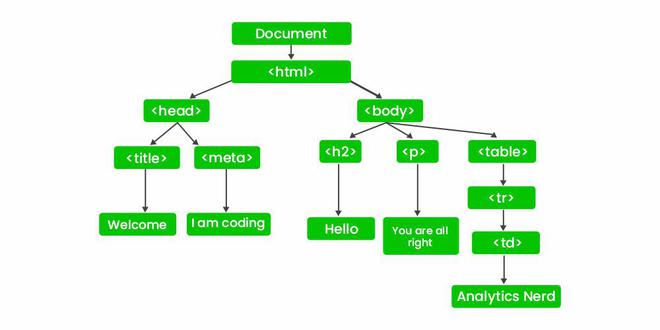ReactJS Virtual DOM revolutionizes frontend development by introducing a lightweight, efficient abstraction of the browser’s DOM. This virtual representation mirrors the actual DOM, enabling React to efficiently update and render components in response to state changes. By comparing the virtual DOM with the real DOM and selectively applying changes, React minimizes unnecessary re-renders, enhancing performance and user experience. This approach empowers developers to build dynamic, interactive web applications with ease, focusing on component logic rather than manual DOM manipulation. Ultimately, React’s Virtual DOM streamlines development workflows, optimizing rendering efficiency and facilitating the creation of responsive, scalable web interfaces.
What is a DOM?
DOM stands for ‘Document Object Model’. In simple terms, it is a structured representation of the HTML elements that are present in a webpage or web app. DOM represents the entire UI of your application. The DOM is represented as a tree data structure. It contains a node for each UI element present in the web document.

What is a Virtual DOM?
React uses Virtual DOM exists which is like a lightweight copy of the actual DOM(a virtual representation of the DOM). So for every object that exists in the original DOM, there is an object for that in React Virtual DOM. It is exactly the same, but it does not have the power to directly change the layout of the document. Manipulating DOM is slow, but manipulating Virtual DOM is fast as nothing gets drawn on the screen. So each time there is a change in the state of our application, the virtual DOM gets updated first instead of the real DOM.

How Virtual DOM actually makes things faster?
When anything new is added to the application, a virtual DOM is created and it is represented as a tree. Each element in the application is a node in this tree. So, whenever there is a change in the state of any element, a new Virtual DOM tree is created. This new Virtual DOM tree is then compared with the previous Virtual DOM tree and make a note of the changes. After this, it finds the best possible ways to make these changes to the real DOM. Now only the updated elements will get rendered on the page again.
Methods of DOM:
- write(“string”): Writes in document area
- writeln(“string”): Writes in a new line in the document area
- getElementById(“id”): Returns the element with the passed ID
- getElementByName(” name” ): Returns the element with the passed name
- getElementByTagName(“tagname”): Returns the element with the passed tag name
- getElementByClassName(“classname”): Returns the element with the passed class name
Now let’s understand the differences between Real Dom and virtual Dom:
| Real DOM | Virtual DOM |
|---|---|
| DOM manipulation is very expensive | DOM manipulation is very easy |
| There is too much memory wastage | No memory wastage |
| It updates Slow | It updates fast |
| It can directly update HTML | It can’t update HTML directly |
| Creates a new DOM if the element updates. | Update the JSX if the element update |
| It allows us to directly target any specific node (HTML element) |
It can produce about 200,000 Virtual DOM Nodes / Second. |
| It represents the Ul of your application | It is only a virtual representation of the DOM |
In conclusion, the ReactJS Virtual DOM stands as a pivotal innovation in modern web development, revolutionizing the way developers conceptualize and manage user interfaces. By introducing a lightweight, efficient abstraction layer over the actual DOM, React enables developers to write declarative code that describes the desired UI state, while efficiently handling the underlying DOM manipulations behind the scenes.
The Virtual DOM’s reconciliation algorithm minimizes unnecessary updates by intelligently computing the difference between the current and desired UI states, resulting in optimized rendering performance and improved user experience. This approach not only enhances the responsiveness of web applications but also simplifies the development process by abstracting away the complexities of manual DOM manipulation and event handling.
Furthermore, the Virtual DOM’s architecture lays a solid foundation for React’s component-based development model, facilitating modular, reusable, and maintainable code structures. This modular approach encourages code encapsulation, separation of concerns, and team collaboration, leading to more scalable and robust applications.
In summary, the ReactJS Virtual DOM embodies the core principles of simplicity, efficiency, and developer experience, empowering developers to build high-performance, interactive web applications with ease. Its widespread adoption and continued evolution underscore its significance as a fundamental building block in the modern web development landscape.

